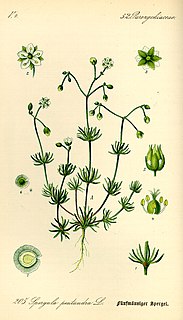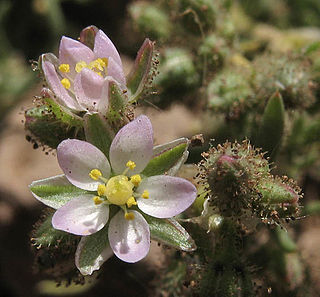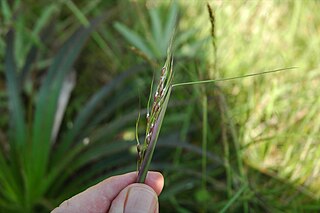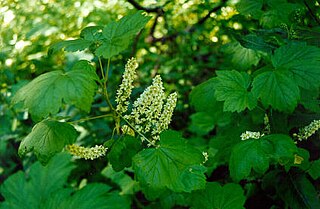
Botrychium is a genus of ferns, seedless vascular plants in the family Ophioglossaceae. Botrychium species are known as moonworts. They are small, with fleshy roots, and reproduce by spores shed into the air. One part of the leaf, the trophophore, is sterile and fernlike; the other, the sporophore, is fertile and carries the clusters of sporangia or spore cases. Some species only occasionally emerge above ground and gain most of their nourishment from an association with mycorrhizal fungi.

Lapsana communis, the common nipplewort, is a species of flowering plant in the family Asteraceae. It is native to Europe and southwestern Asia. and widely naturalized in other regions including North America.

Elwendia persica is a plant species in the family Apiaceae. It is related to cumin and sometimes called black cumin, blackseed,, black caraway, and has a smoky, earthy taste. It is often confused with Nigella sativa, by which it is often substituted in cooking.

Spergula is a genus of flowering plants in the family Caryophyllaceae. Their usual English name is spurry or spurrey. Commonly found in grassland, the genus originated in the northern hemisphere, but is now found worldwide.

Triadenum, known as marsh St. John's worts, is a small genus of flowering plants in the family Hypericaceae. The genus is characterized by opposite, blunt-tipped leaves and pink flowers with 9 stamens. They are distributed in North America and eastern Asia.

Spergularia is a genus in the family Caryophyllaceae, containing salt-tolerant plants known as sandspurrys and sea-spurreys. There are about 60 species.

Spergularia bocconei, Boccone's sandspurry, Greek sea-spurrey or Boccone's sea-spurrey, is a species of the genus Spergularia, in the family Caryophyllaceae. It is named after the Sicilian botanist Paolo Boccone. Scheele first published it as Alsine bocconi in 1843. It was transferred to the genus Spergularia by Graebner in 1919. Pedersen placed the species in genus Spergula in 1984.

Oxalis violacea, the violet wood-sorrel, is a perennial plant and herb in the family Oxalidaceae. Oxalis species are also known as sour grass, sour trefoil, and shamrock.

Spergularia rubra, the red sandspurry or red sand-spurrey, is a plant species in the family Caryophyllaceae. It is native to Europe, Asia and North Africa, and it is present on other continents, including North and South America and Australia, as an introduced species and in many areas a common weed. It grows in a wide variety of habitat types.

Sisyrinchium montanum, the blue-eyed-grass, American blue-eyed-grass, or strict blue-eyed grass, is a grass-like species of plant from the genus Sisyrinchium, native to northern North America from Newfoundland west to easternmost Alaska, and south to Pennsylvania in the east, and to New Mexico in the Rocky Mountains. It has also been introduced to parts of France, likely during the First World War.

Sambucus racemosa is a species of elderberry known by the common names red elderberry and red-berried elder.

Piptochaetium, or speargrass, is a genus of New World plants in the grass family, native to North and South America. Piptochaetium is a bunchgrass genus in the tribe Stipeae.

Ribes hudsonianum is a North American species of currant, known by the common name northern black currant.

Spergularia canadensis is a species of flowering plant in the family Caryophyllaceae, known by the common name Canadian sandspurry. It is native to North America, where it is known from mainly coastal habitat. It is found along the coastline of Canada and northern parts of the United States, from Alaska to northern California on the West Coast, and as far south as New York on the East Coast.

Spergularia macrotheca is a species of flowering plant in the family Caryophyllaceae known by the common name sticky sandspurry. It is native to western North America from British Columbia to Baja California, where it grows in many types of moist coastal and inland habitat, often in alkaline and saline substrates. It may be found in marshes, alkali flats, beaches, meadows, seeps, and vernal pools. It is a perennial herb producing a narrow stem up to 40 centimeters long with a woody, thickened base and taproot. They may grow erect or prostrate across the ground. It is covered in sticky glandular hairs, especially in the inflorescence. The stems are lined with fleshy linear leaves, sometimes tipped with spines. The leaves are accompanied by triangular stipules up to a centimeter long each. Flowers occur in clusters at the end of the stem as well as in leaf axils. The small flowers have five pointed sepals and five oval white to lavender-pink petals. The fruit is a capsule containing tiny reddish brown, winged seeds.

Spergularia media is a species of flowering plant in the family Caryophyllaceae known by the common names media sandspurry and greater sea-spurrey. It is native to Eurasia and the Mediterranean, where it grows in many types of habitat, including disturbed areas, including places with saline substrates, such as salt marshes and beaches. It is known in many other parts of the world as an introduced species and a common roadside weed. In North America it is a "highway halophyte", often springing up at the margins of roads that are heavily salted in the winter.

Spergularia villosa is a species of flowering plant in the family Caryophyllaceae known by the common name hairy sandspurry. It is native to southern South America, and it is known in the southwestern United States and Baja California as an introduced species and casual weed. It grows in a wide variety of habitat types. It is a small perennial herb producing a sprawling stem up to 30 centimeters long with a woody base. It is coated in glandular hairs. The leaves are generally linear in shape and measure a few centimeters long. They are accompanied by dull white lance-shaped stipules. The flowers have hairy, glandular sepals and five oval whitish petals.

Plantago rugelii is an edible species of flowering plant in the plantain family, Plantaginaceae. It is native to North America, where it occurs in eastern Canada and the central and eastern United States. Its common names include American plantain, blackseed plantain, pale plantain, and Rugel's plantain. The species name rugelii honors Ferdinand Ignatius Xavier Rugel (1806-1879), a German-born botanist and pharmacist.

Spergularia marina, also called Spergularia salina, is a species of flowering plant in the family Caryophyllaceae. It is known as salt sandspurry or lesser sea-spurrey. S. marina is a sprawling annual or sometimes perennial, with stems up to 35 cm (14 in) long. Like other sea-spurrey species, its flowers have white to pink petals, with sepals usually longer than the petals, at 2.5–4 mm (0.1–0.2 in). Plants are salt-tolerant, being found by the sea and in saline areas inland.

Spergularia purpurea, the purple sandspurry, is a species of annual herb in the family Caryophyllaceae (carpetweeds). They have a self-supporting growth form and simple, broad leaves. Individuals can grow to 9 cm.




















